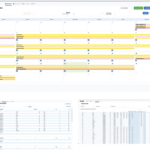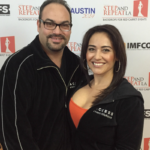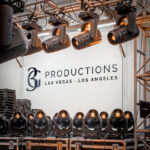Fred Foster Discusses High End Systems’ Merger a Year Out
Stepping into the lobby of ETC’s headquarters in Middleton, Wisconsin, is to step into a stylized historic version of New York City. The reception area is a recreation of Edward Hopper’s Nighthawks diner. Across from that is a “school,” P.S. 8 — named so because that’s where Steve Terry, ETC’s director of standards and industry relations, went to school — where the company holds training classes. Then you notice the Richard Kelly Insurance storefront (human resources) and the “Haberdashery” store (selling ETC souvenirs and swag). But the lobby is also a tribute to the history of theatrical lighting. CEO Fred Foster will point out how the upper walls pay tribute to the innovators of theatrical lighting with faded painted wall signs of Kliegl and Century and Major. Then there’s the “movie theater” (a demo room) called Strand.
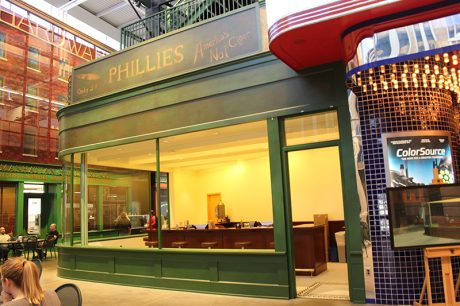
Yes, Foster is there to give the visitor a cook’s tour of the place himself, which he does with great mirth. There is a lot of growth and expansion happening here, but it’s all purposeful. “If you see it, and it moves, we want to be part of it!” he says, and he means it. ETC started out making lighting consoles; today they are focused on anything to do with consoles, lighting fixtures, architectural lighting systems, power distribution and controls, emergency lighting and rigging. Of course, what certainly fits nicely in with that vision is High End Systems, which ETC acquired a little more than a year ago. So, we’ll start there.
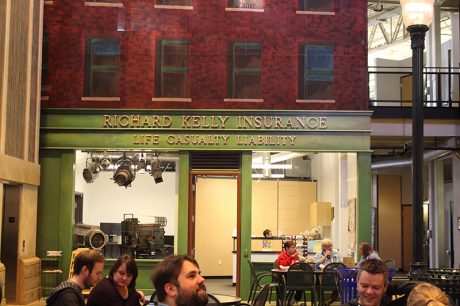
“Love at First Sight”
Foster’s history of being interested in acquiring HES goes back all the way to 1991. The ETC team had its eye on the development of automated lighting, and noticed that HES went “all in” on the technology immediately. (They would impressively go all in on LED lighting, too.) When Barco bought High End Systems in 2008, Foster and others at ETC watched carefully. “At that point, we were very strong in conventional and architectural lighting, and our Eos family of consoles was doing well, but we were still eyeing the pro/concert market.” ETC would finally close the deal and bring HES into the fold in April of 2017.
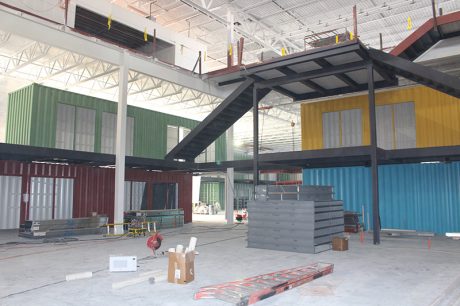
All businesses in this industry face volatility, but HES seemed to have more than its fair share. Foster notes that while at one point the company employed 350, they were down to 65 when ETC bought them. “But those 65 were doing the work of 350,” he notes. One thing that had never wavered, however, was the passion of HES employees. “It was clear to us that they weren’t being allowed to succeed by the previous owners, and when we got involved, it was love at first sight. They knew we cared about lighting and weren’t slaves to the [profit] spreadsheet like a publicly-held company often is. We have the ability to invest in the long-term and do things that make them stronger.”
What ETC has done is “pick up the back office stuff” for HES. Tradeshow logistics, general marketing and public relations are no longer Austin’s obligation. ETC is also employing its distribution savvy on HES. “We’re restructuring distribution around the world. Barco had ceded the European distribution for example, and now we’re ramping up employing our international teams to open markets.”
Foster is looking forward to the synergy of the two companies’ R&D departments. He hints at the development of a moving light addition to the Source Four family, but still designed for the theatrical and conventional markets. “We’ll wait to see how we blend the two technologies, and we’ll have the patience to do it right and develop products true to ourselves.” He notes that HES has developed fan-less automated fixtures — the SolaFrame Theatre — that will be a huge benefit to ETC’s theater audience. The new SolaFrame Theatre from High End uses convection cooling and clever insulation so that it’s quieter than a whisper even when you’re standing right next to the fixture.
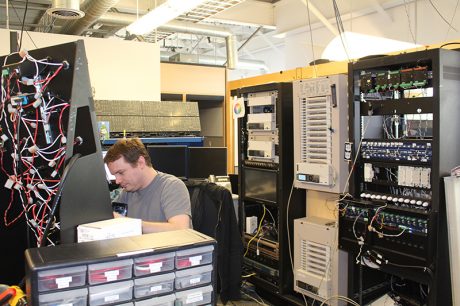
New Products, New Markets
Meanwhile, on the ETC side of things, the company continues to explore how to develop new and better ways to create rich visual environments. “I’m an old stagehand and can work sailboats, so back in 2007 we decided to get into rigging systems and create better ones,” Foster says. He acknowledges that there was strong competition out there, and they were the new kids on the block. “We didn’t know what we didn’t know — and you have someone like Clancy who have been around for 120 years, so we were cautious.” After originally wading into the high school market, they’ve expanded their Prodigy line of hoists (as well as their Quicktouch and Foundation controllers) to excel in theater and entertainment spaces of all sizes.
Here again, ETC looked to expand into an area by acquiring quality products and experts. Foster tells how the large scoreboard company, Daktronics had purchased Vortek, a rigging and hoists control company. “I said to them, ‘Hey, I bet you’d rather just be a scoreboard company again,’” he says with a laugh. Sure enough, Daktronics saw that it made sense to divest itself from that business and, in August 2014, ETC embraced the Vortek hoists, which can handle up to 2,000 pounds with speeds up to 180 feet per minute, plus can be adaptable to non-standard layouts. There again, there was some consolidation of manufacturing to the Wisconsin factories, but the talent behind the R&D has remained in upstate New York.
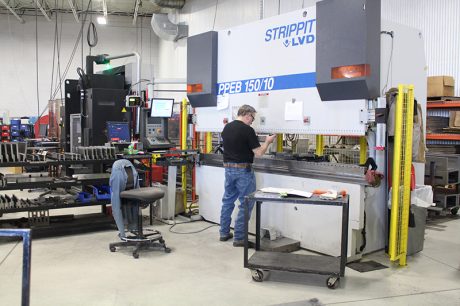
Foster likes to keep people happy where they are when possible. “We have to get the best people, and that requires learning how to work with them efficiency and in a manner that keeps them happy.” Attracting and keeping the best talent wherever they are is something that ETC places a premium on. Foster mentions that they recently appointed Sarah Clausen as senior product manager in charge of the High End Systems’ line of Hog consoles — even though she’s based in Germany. She has been working with the team to create a great cross-pollination between engineers and programmers. “She is getting them talking to each other, understanding the challenges and tackling the issues. It’s exciting to see what that level of exchange is yielding.”
Foster is especially excited about High End’s SolaFrame series, particularly the 750, the newest and smallest framing fixture in the automated tool family. “It has an amazing amount of features. If you’re a venue that needs a smaller moving light but want something with the widest array of effects, there’s nothing else out there quite like this.” On the other end of the spectrum, there’s also the new SolaFrame 3000. Announced at Prolight + Sound recently, the fixture will ship in July and delivers unprecedented brightness — 35,000 lumens — from an all-LED source.

The Walking Tour
We step out of the lobby and onto the warehouse floor, where the attention to making an interesting visual environment continues. Foster points out pathway markers along the floor: Red and green projected gobos point out where it’s safe to walk and where the forklift driving paths are. “Usually factories use safety decals or stickers on the floor to make sure people know where to go,” he says. “A manufacturing engineer thought, we’re a lighting company, there has to be a better way.” They made custom glass gobos that project safe walking paths.
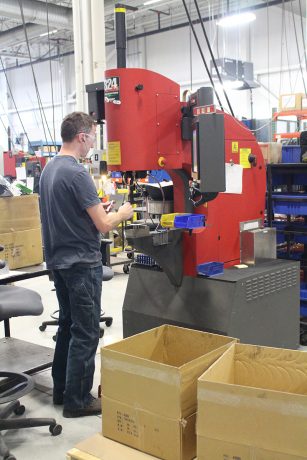
And the visual interest isn’t just related to safety. Further back, there’s a large dragon hanging by the dock made out of colorful boxes. “That came out of our Fun Committee,” Foster tells with glee that he heads a company that even has a Fun Committee.
Foster is also proud that the often-expanding warehouse accommodates ETC’s commitment to their products being U.S.-made. “All manufacturing happens here in this plant or another one we have a few miles up the road,” he says. For him, it’s not just the right thing to do, but for this industry, smart. “If we get an order in the morning suddenly and we don’t have that in stock, we can almost always configure the team together and put it together to ship that night,” he says. “If we were manufacturing overseas, sure, the parts and labor would cost less, but if we had that same emergency, shipping by air would still be a delay and cost so much more it would erase any price advantage of building our products anywhere but here. This way, we’re extremely flexible and responsive, and that gives ETC a significant edge.”
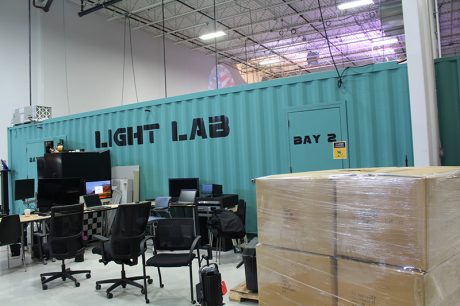
We move from the warehouse into a new section of the factory that is still being built (hardhat required). The new expansion will house meeting spaces and offices for the marketing and R&D departments. This is the land of repurposed cargo containers. He had them painted bright colors, cut them up, stacked them and expanded them, giving the whole section a kind of adult theme park vibe. A major component of the new section of their factory is a room with a high ceiling to further test their latest rigging systems. Moving into the customer service department, he points out that this part of the operation is also 7/24/365, and when a call comes in, it is always taken care of by someone who works locally, never rerouted overseas. Like ER doctors, the people here get “shifts” and take turns being on call so when there is a problem at 2 a.m. on a Saturday morning, there is someone to answer the call.
In the R&D department, Foster discusses the increasing challenges of finding the sweet spot of when the sales team is comfortable releasing a new product (soon!) to when the engineer team is comfortable releasing a new product (never!). “It’s an increasingly technologically complicated industry, and what we’re always grappling with is what our Vice President of R&D Dennis Varian calls measuring against our ‘riskometer.’” It’s the art and science of determining how quickly a new product can go out the door measured against the confidence that it is reasonably bug-free.
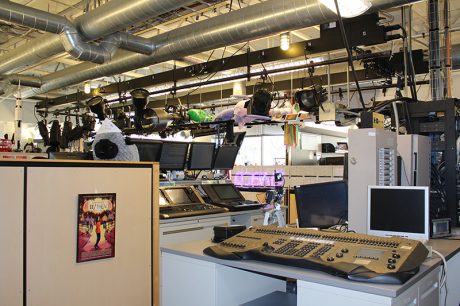
Going Forward
“The road map for next five years is to look at every aspect of the system — not just luminaires or LED technology, but data systems, controllers, everything,” Foster says. “The controllers need to be able to navigate colors more nimbly. There are colors that can be reached now that artists haven’t been able to make until the advent LED. We must be able to let our users take advantage of those capabilities. That’s been a focus on the control side for both our entertainment and architectural groups. And, of course, LEDs have changed power needs everywhere.” But no one is being left behind either: “We are fully engaged with the incandescent market all the while embracing the new possibilities. We have witnessed the moving fixture revolution and the LED disruption. We’ve seen consoles change to control these effects. We’re watching rigging systems change from counter-weight or dead-hung systems to automated hoists. It’s very exciting how many people are really embracing a modern solution to every aspect of production at every level. And here at ETC we want to provide them with the very best products to do just that.”
